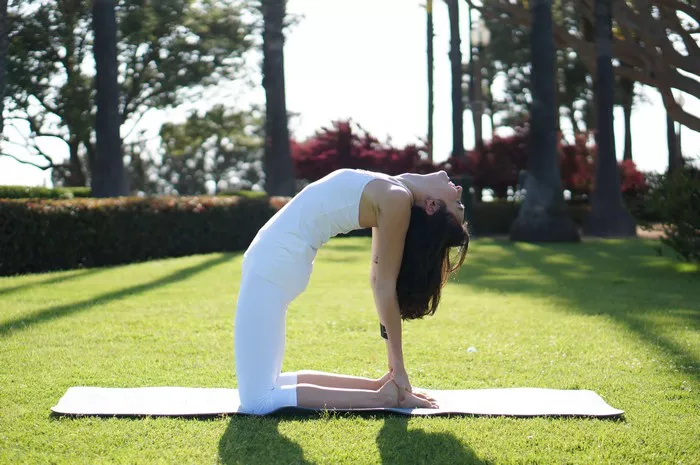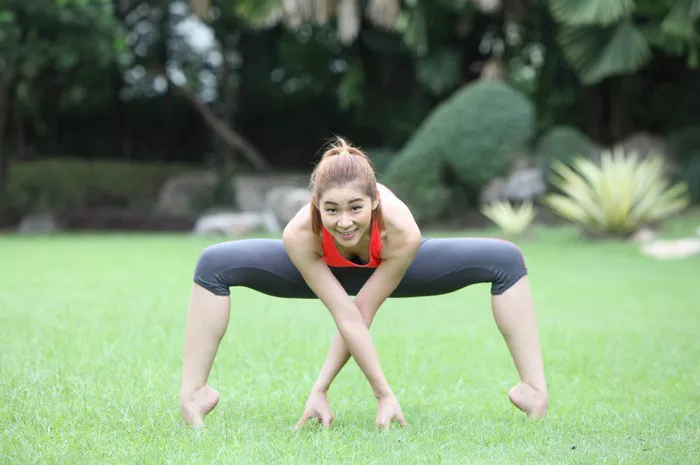Yoga is a versatile practice that offers benefits for both the mind and body. While many people practice yoga individually, there is a growing interest in practicing yoga as a group. One particularly fun and challenging way to explore yoga is through gymnastics yoga poses for three people. These poses combine the principles of traditional yoga with the athleticism and balance of gymnastics, creating a dynamic and engaging experience for groups. In this article, we will explore several gymnastics yoga poses for three people, covering their benefits, how to perform them, and tips for safety and success.
What is Gymnastics Yoga?
Gymnastics yoga is a fusion of gymnastics movements and traditional yoga postures. It incorporates elements like flexibility, strength, coordination, and balance from gymnastics into the mindful flow of yoga. These poses often require more advanced physicality and precision, making them great for those who want to challenge themselves physically and mentally.
When you practice gymnastics yoga as a group of three, you can engage in partner-based poses, where each person contributes to the balance, stability, or support of the others. This requires effective communication, trust, and teamwork, making it not only a physical challenge but also a bonding experience for the group.
The Benefits of Gymnastics Yoga Poses for Three People
Before we dive into specific poses, it’s important to understand the numerous benefits that gymnastics yoga can offer when practiced in a trio:
Increased Strength: Gymnastics yoga requires significant physical strength, particularly in core stability and upper body strength. Poses that involve balancing, holding weight, or lifting others build muscle and endurance.
Improved Flexibility: The deep stretching involved in gymnastics yoga improves flexibility in both the lower and upper body. Flexibility enhances your ability to perform more challenging poses and reduces the risk of injury.
Better Balance and Coordination: Many of the poses require precise balance and coordination, especially when one person is supported by the others. Working together as a group improves overall coordination and teaches you how to balance not just yourself, but also others.
Mental Focus: These poses demand a lot of concentration. You’ll need to be fully present in the moment, whether you’re focusing on your breath, your body, or coordinating movements with the others.
Teamwork and Trust: One of the biggest advantages of practicing gymnastics yoga in a group is the opportunity to work together and build trust. This is especially true when one person is balancing or relying on the support of the others.
Preparing for Gymnastics Yoga Poses for Three People
Before you attempt any gymnastics yoga poses, it’s important to be prepared physically, mentally, and emotionally. Here are some tips for a safe and effective practice:
Warm-Up: Always start with a full-body warm-up to prevent injury. Focus on loosening up your joints, warming up the muscles, and increasing your heart rate. A few rounds of Sun Salutations (Surya Namaskar) are a great way to begin.
Communicate: Since these poses require coordination and balance, communication between the three participants is essential. Agree on signals or verbal cues to let everyone know when to move, when to hold, and when to adjust.
Strength and Flexibility: Ensure that all participants have a basic understanding of yoga and gymnastics principles, such as core strength, alignment, and flexibility. If one person is not as flexible or strong, they may need support or modifications.
Safety First: Always prioritize safety. Don’t attempt advanced poses without proper instruction or preparation. Practice in a soft, safe environment where you have ample space, such as on yoga mats or padded flooring.
Gymnastics Yoga Poses for Three People
Now that we’ve covered the benefits and preparations, let’s explore some gymnastics yoga poses that you can try with a group of three. These poses range from simple to more advanced, so feel free to start with the basics and gradually progress as you build strength, flexibility, and confidence.
1. Three-Person Downward-Facing Dog (Adho Mukha Svanasana)
This variation of the classic Downward-Facing Dog pose is great for building strength, flexibility, and coordination.
How to do it:
Have all three people start in a standard Downward-Facing Dog position (hands on the floor, feet wide apart, and hips lifted).
The person in the middle will remain in the traditional Downward Dog position, while the two others will come into the same position on either side.
The two people on the sides will hold the legs of the person in the center to give them support and stability. The hands can stay on the floor, or one person may try lifting one foot off the ground for added challenge.
Benefits:
- Improves upper body strength
- Increases flexibility in the hamstrings and calves
- Builds coordination and teamwork
2. Three-Person Boat Pose (Navasana)
Boat pose is excellent for strengthening the core muscles, and practicing it as a trio adds an element of support and challenge.
How to do it:
Start by having everyone sit in a circle with their legs bent and feet flat on the floor.
Each person will then lift their feet off the floor and balance on their sit bones, creating a “V” shape with their legs.
Link arms or hold hands for support and balance.
If you’re feeling advanced, the group can straighten their legs to form a deeper “V” shape.
Benefits:
- Strengthens the abdominal muscles
- Improves balance and coordination
- Enhances focus and concentration
3. Three-Person Standing Forward Fold (Uttanasana)
This variation of the Standing Forward Fold involves all three participants folding forward together, helping with flexibility and connection.
How to do it:
Stand in a triangle formation with feet hip-width apart, about two feet apart from each other.
Each person will bend forward, folding at the hips while keeping the spine long.
Hold each other’s wrists, elbows, or shoulders for added support and balance.
Engage your core and keep your breathing steady as you fold, maintaining a relaxed but strong posture.
Benefits:
- Stretches the hamstrings, calves, and spine
- Promotes flexibility and circulation
- Strengthens the core and improves posture
4. Three-Person Plank Pose (Kumbhakasana)
Plank pose helps build core strength, arm strength, and stability. Doing it with three people requires coordination and focus.
How to do it:
Start by having all three people line up in a row on the floor, each in a standard plank position (hands under shoulders, body in a straight line from head to heels).
The three individuals will support each other by placing one hand or foot on the other’s shoulder or body. Each person should keep their core engaged and avoid sagging their hips.
Maintain the plank position for 20-30 seconds, ensuring that everyone maintains proper form.
Benefits:
- Strengthens the core, shoulders, arms, and legs
- Improves endurance and stamina
- Builds trust and teamwork
5. Three-Person Chair Pose (Utkatasana)
This dynamic pose requires strength, balance, and focus. Practicing it with three people turns it into a fun and collaborative effort.
How to do it:
Begin by having everyone stand side by side with feet together.
Bend your knees and lower your hips as if you are sitting in an imaginary chair. Keep your chest lifted and your arms raised in front of you.
Each person can support one another’s backs or arms, creating a triangle shape with the bodies. This pose requires balance and strength as you hold the position.
Benefits:
- Builds lower body strength, particularly in the thighs and glutes
- Improves posture and stability
- Enhances coordination and teamwork
6. Three-Person Crow Pose (Bakasana)
Crow Pose is an arm balance that requires core strength, balance, and coordination. In a group of three, the people supporting one another can help lift each other into the pose.
How to do it:
Begin with one person in the traditional Crow Pose, balancing on their hands with their knees resting on their elbows.
The other two individuals will provide support by either holding the legs or gently lifting the person’s feet off the ground.
The goal is for all three to maintain balance together in a supported position.
Benefits:
- Builds arm, core, and wrist strength
- Improves focus and concentration
- Helps develop trust and teamwork
7. Three-Person Wheel Pose (Urdhva Dhanurasana)
Wheel Pose is an advanced backbend that opens up the chest and strengthens the back. Practicing it in a trio adds complexity and support.
How to do it:
Two participants will begin in the traditional Wheel Pose, with their hands and feet on the floor, lifting their bodies into a backbend.
The third person will gently assist by supporting the middle person’s lower back or hips.
Ensure that the core is engaged and the spine is lengthened to avoid compression or injury.
Benefits:
- Opens the chest, shoulders, and hips
- Increases spine flexibility and strength
- Improves overall body awareness
Tips for Practicing Gymnastics Yoga Poses for Three People
Start Simple: If you’re new to group yoga, begin with simpler poses and build up to more advanced ones as you gain confidence and coordination.
Communicate Clearly: Before attempting any pose, discuss the movements with your group and agree on signals or cues to make transitions smooth.
Support Each Other: The key to success in partner-based poses is trust. Be patient, supportive, and aware of each other’s limits.
Use Props: If necessary, use props such as blocks, straps, or blankets to make poses more accessible or comfortable.
Don’t Rush: Take your time with each pose. Remember that yoga is about finding balance and staying mindful, not rushing through the movements.
See Also: What Are Some Fun Two-Person Yoga Poses to Try Together?
Conclusion
Gymnastics yoga poses for three people are an excellent way to improve strength, flexibility, balance, and coordination while building deeper connections with your fellow practitioners. These poses can be both fun and challenging, providing opportunities for growth, trust, and communication. Whether you’re a seasoned yogi or new to gymnastics yoga, practicing as a group can deepen your yoga practice and enhance your overall well-being. So gather two friends, roll out your mats, and enjoy the many benefits of gymnastics yoga together.
You Might Be Interested In:























